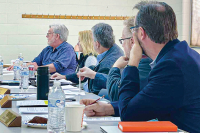The secretive, intelligent and prolific crow
Like most commonly observed objects, crows flit across our field of vision unheeded. Caw-caw-cawing unmusically … flap-flap-flapping over the fields … dressed as if for a funeral … iridescent pieces of black flannel waving in the breeze. We hear and see them … but we don’t really pay attention. We rarely think about them … we never ask ourselves: “What are these birds up to?”
Within the last decade, however, crows have decided to relocate into the valley we live in west of Bryson City. This flock is composed of perhaps 30 individuals ... maybe more … maybe less. Counting crows can be a problem.
They all look alike … and no crow stays in one place for very long. But I’d say we’ve got about 30 crows … more than enough.
They primarily feed around the barn on whatever chicken, rabbit, and horse feed gets scattered on the ground. But they will eat almost anything. They are, I have observed, fond of apples … especially golden Grimes apples. I have seen them pecking at tomatoes and squash. But I have never observed a crow eating a green bean.
They apparently roost and nest in a thicket of scrub pine on a ridge above the valley. Being crows they are, of course, secretive about where they roost. They are secretive about everything. But I have watched them through binoculars late in the evening. They fly in every direction as a diversion but eventually they slip away … one by one … into the pine grove on that ridge.
Of late, they have become rather tame and often come down to feed and mess around in the garden ornamental shrubs next to our home, when they think no one is around; that is, when both of our vehicles are gone. You did know that crows can count, didn’t you?
Related Items
Well-funded high-caliber scientific research has established that all crows can count to three ... not a few can count to four ... and the occasional crow can get to five. The North American record for counting by a crow is eight. It was set by a crow residing in Ithaca, N.Y. There is suspicion that the crow was tutored at the Cornell University Lab. Be that as it may, crows are good counters.
When they think no one is home, I sit by my window and listen to the crows talking things over. I have no idea what they’re talking about. They don’t caw when there’re discussing things. At this time, their vocalizations consist primarily of low rattling and gurgling sounds. One will rattle for a while, then another one will gurgle for awhile in response. I keep asking myself, “What are these birds up to?”
I have never observed a large roost of crows, which is properly referred to not as a flock but as a “congress of crows,” but in some places they form winter enclaves that number into the thousands. One standard source reports winter flocks of up to 200,000 birds.
I have an AP wire service clip in my “Crow” file dated Jan. 6, 1987, and titled “Crows Decide Illinois Town Is For The Birds.” The town in question was Danville, Ill., which had suffered a crow inundation that broke branches, pulled down power lines, and bombarded streets and houses with droppings.
From the article: “‘It’s like an Alfred Hitchcock movie over here. These birds are driving us all crazy,’ said Irene Hall, who lives on Oak Street, one of the crows’ favorite spots.”
The first naturalists in our part of the world were the ancient Cherokees. They didn’t miss a trick in regard to the intricacies of plant and animal life. They liked to closely observe the mundane, and then make it a part of their oral traditions.
The Cherokee word for crow is “Koga.” According to one of their stories, Koga acquired its black color in a futile attempt to obtain the first fire. In another story, two crows were selected to be the guards of a gambler named Brass. Anthropologist James Mooney collected this story in the late 1880s while living among the Cherokees in the Big Cove section of the Qualla Boundary in Western North Carolina.
“They tied his hands and feet with a grapevine and drove a long stake through his breast, and planted it far out in the deep water,” Mooney recorded in Myths of the Cherokee (1900). “They set two crows on the end of the pole to guard it and called the place Ka-gun-yi: ‘Crow place.’ But Brass never died, and cannot die until the end of the world, but lies there always with his face up. Sometimes he struggles under the water to get free, and sometimes the beavers, who are his friends, come and gnaw at the grapevine to release him. Then the pole shakes and the crows at the top cry ‘Ka! Ka! Ka!’ and scare the beavers away.”
What better lookouts than a pair of crows?
George Ellison wrote the biographical introductions for the reissues of two Appalachian classics: Horace Kephart’s Our Southern Highlanders and James Mooney’s History, Myths, and Sacred Formulas of the Cherokees. In June 2005, a selection of his Back Then columns was published by The History Press in Charleston as Mountain Passages: Natural and Cultural History of Western North Carolina and the Great Smoky Mountains. Readers can contact him at P.O. Box 1262, Bryson City, N.C., 28713, or at This email address is being protected from spambots. You need JavaScript enabled to view it..









